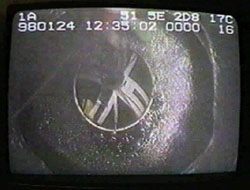
|

|
|
|
©
Per Olof Hulth
|
|
|
An
optical module hits the surface of the water. Below it
is a column of water that will hold a string of these
modules. The column will freeze, holding the modules in
place until the Antarctic ice melts.
|
|
|
|

A
literary essay about AMANDA by Francis Halzen
page 4
In
principle, Super-K ought to detect equal numbers of low-energy
neutrinos radiating in from all sides from the collisions
of cosmic rays with the atmosphere. But in the past three
years, the detector found that fewer neutrinos were coming
in from the far side of the earth than from the near side.
The only explanation for the discrepancy, the physicists concluded,
was that some muon neutrinos, which Super-K can detect, must
have changed into undetectable tau neutrinos as they passed
through the earth.
The Super-K data are so precise, so elegantly conceived, that
they seem to prove once and for all that neutrinos have mass—thereby
punching a hole in one of the standard model’s tires.
Whether fixing that hole will require a simple patch or a
complete overhaul remains to be seen: Super-K can only measure
the difference in mass between two neutrinos—a quantity
somewhere between 0.1 and 0.01 electron volt. Based on that
figure and other data, however, many physicists now estimate
that the three types of neutrinos have a combined mass of
around 0.1 electron volt.
What Super-K does not do—what no working detector has
ever done—is pay attention to neutrinos from beyond our
galaxy. Enter AMANDA. Because high-energy neutrinos are 1012
times easier to detect than solar neutrinos, our telescope
can afford to trade sensitivity for size. The same volume
of water surveyed by 13,000 photomultipliers in Super-K is
surveyed by only around ten in AMANDA; our photomultipliers
are less than half as large; and ours do not detect solar
neutrinos at all. But AMANDA, when complete, will watch over
thousands of times more water than Super-K. As a result, it
will track neutrinos across as far as a kilometer, whereas
Super-K can track them across no more than fifty meters.
When a high-energy neutrino collides with a proton in the
ice, it creates a muon—a particle closely related to
the electron but more than 200 times more massive—that
continues along the neutrino’s upward path, streaming
photons along its sides like a bottle rocket. The result is
a hurtling cone of blue Cherenkov light—light of the
same kind emitted by nuclear reactors. From the timing of
the cone’s reception by our grid of photomultipliers,
the muon’s direction can be reconstructed and the direction
of the incoming neutrino inferred.
|
